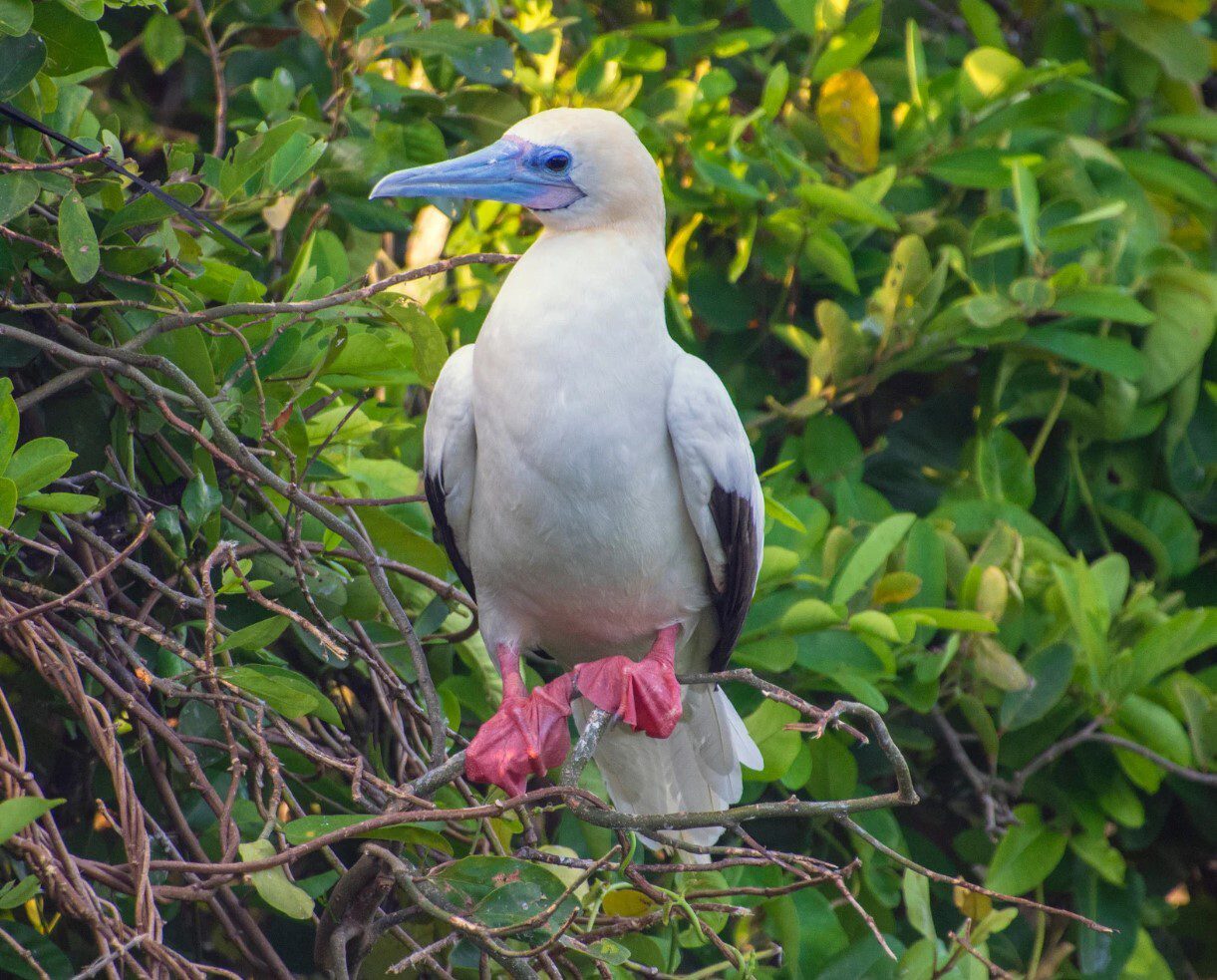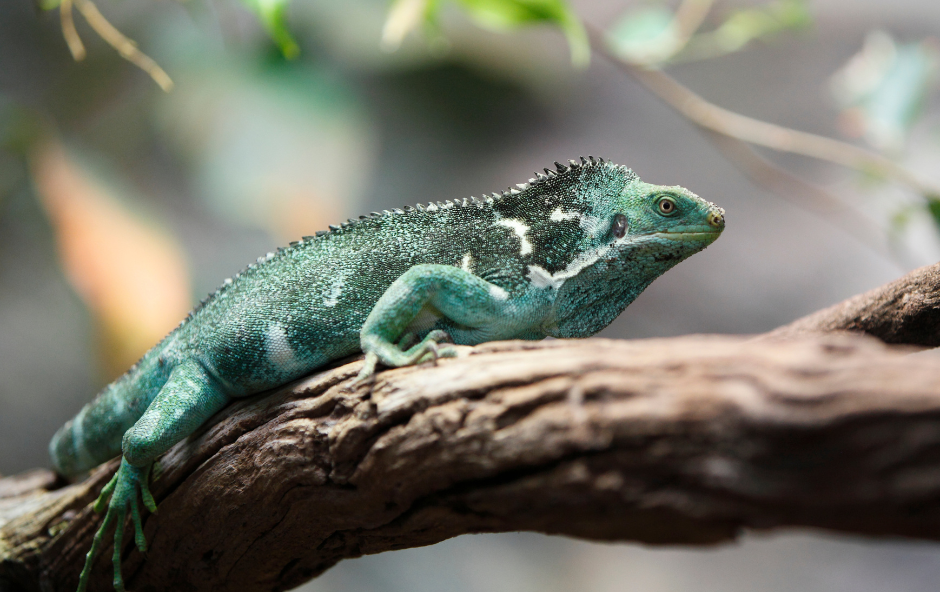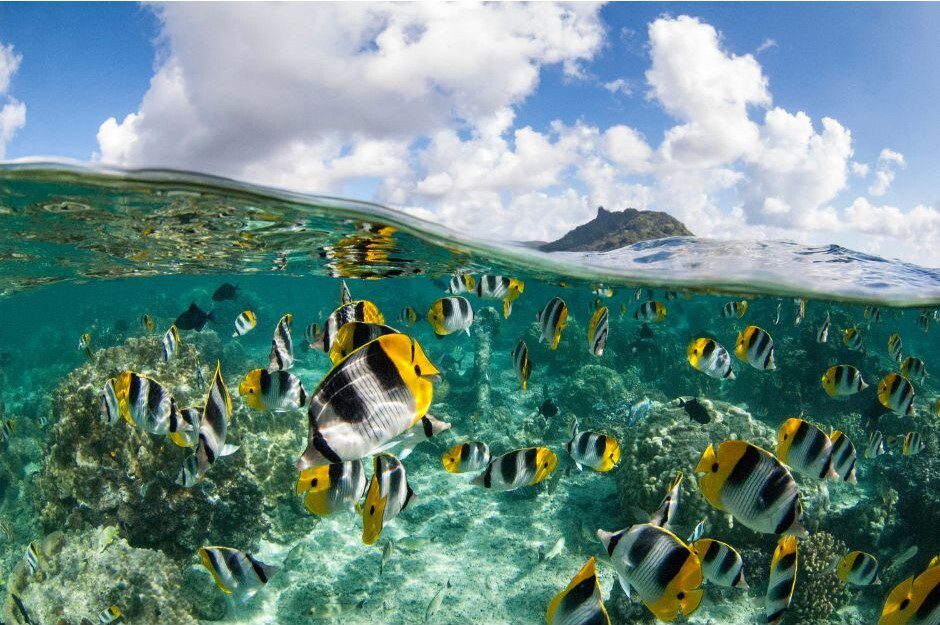South Pacific Trip Inspiration
Speak to a South Pacific expert today
and start planning your tailor-made holiday

Ruth
South Pacific Expert
Read all about the wonderful marine and wildlife you can see in the South Pacific Islands

The South Pacific is often thought of in terms of turquoise lagoons, palm-fringed beaches and thatched overwater bungalows. But look closer, and you’ll find its real magic lies in the life that inhabits it. From the lush rainforests of Samoa to the manta rays gliding off Fiji’s reefs, these islands are bursting with biodiversity. If you’re planning a trip and want to know what animals you might encounter, where to find them, and when to visit, here’s our expert guide, helpfully split into marine and other wildlife sections.

The backbone of the South Pacific’s ecosystems, coral reefs are living structures built over thousands of years by tiny coral polyps, which release calcium carbonate to form hard skeletons. These tiny structures live in symbiosis with microscopic algae that provide energy through photosynthesis, giving reefs their vibrant colours. Biologically, reefs are often called the “rainforests of the sea,” supporting an estimated 25% of all marine species, from fish and molluscs to turtles and sharks. Their impact goes far beyond biodiversity: reefs protect coastlines from erosion, support fisheries that island communities rely on, and attract travellers seeking snorkelling and diving.
Efforts to preserve these exceptionally biodiverse areas have increased in recent years. Outrigger Fiji Beach Resort operates a sustainable coral-planting programme (Corals for Conservation), as well as eco-tours and cultural immersion, all of which support the local communities. On your visit, expect to see a riot of reef fish; including parrotfish, butterflyfish, and clownfish.
The Cook Islands – Aitutaki Lagoon has shallow, clear waters filled with butterflyfish, wrasse and eagle rays, perfect for snorkelling. Rarotonga’s outer reefs are the perfect place to spot turtles, reef sharks and other pelagic species.
When to Go - Year-round. Coral spawning often happens after full moons in late spring and summer months, which can bring even more activity to the reefs.

A variety of different types of whales can be found in the South Pacific, including humpback, baleen and toothed whales.
Undoubtedly, the star attraction of this region in the winter months is the migratory humpback whale. Each year they travel thousands of kilometres from feeding grounds in Antarctica to breed and calve in the warmer lagoons.
Baleen whales filter-feed on krill and small fish. The whale calves are born with insulating blubber to prepare them for the colder waters ahead. Male whales are famous for their complex songs, which can last for hours and are thought to play a role in courtship and communication.
Moorea in French Polynesia is one of the best places to see humpback whales. Its lagoons are also reliable for blacktip reef sharks and stingrays. These creatures can also be sighted in Fiji, the Cook Islands (Rarotonga and Aitutaki) or Samoa (visible offshore around Savai’i). For a chance to see these incredible creatures for yourself, take a look at our Whale Watching, Reef and Rays trip to French Polynesia.

Dolphins are highly social, intelligent marine mammals, best known for their playful behaviour and acrobatic leaps. They use echolocation to hunt fish and squid, sending out clicks and listening for echoes to pinpoint prey in the water. With streamlined bodies, keen eyesight, and cooperative hunting strategies, dolphins are perfectly adapted to life in the warm, open seas of the Pacific. Species like spinner dolphins are especially common around islands such as Fiji and Samoa, often seen travelling in pods that can number in the hundreds.

Whilst sharks have a fearsome reputation, here in the South Pacific they are both key apex predators and a critical ecological factor in keeping a healthy ecosystem. By preying on weak, sick, or overabundant species, they help maintain healthy populations of fish and prevent any single group from dominating the reef. This regulation supports coral growth and biodiversity, creating more resilient reef systems. With streamlined bodies, acute senses, and efficient gill-based respiration, sharks are superbly adapted hunters, perfectly evolved to the tropical seas they inhabit. Beyond ecology, sharks also have a cultural and economic impact: many Pacific communities view them as sacred, and shark diving tourism contributes significantly to local economies while encouraging conservation.
Common species include blacktip and whitetip reef sharks, grey reef sharks, bull and tiger sharks. Hammerheads are also visible in certain areas of the region. Each species has distinct biological traits that suit its habitat and role in the marine ecosystem.

Powerful and stocky, bull sharks are unusual because they tolerate both saltwater and freshwater, occasionally venturing up rivers. Growing to 3.5 metres, they have broad diets, taking fish, rays, and even other sharks. Their adaptability makes them one of the most formidable predators in Fiji’s Beqa Lagoon.
Among the largest species found in the region, tiger sharks can grow over 4 metres. Their name comes from the faint, dark stripes along their bodies, especially visible in juveniles. They are opportunistic feeders with extremely broad diets, consuming fish, turtles, seabirds, and sometimes inedible objects - a trait that’s earned them a reputation as “garbage collectors of the sea.”
Recognisable instantly by their wide, hammer-shaped heads, hammerheads use this unique feature to improve manoeuvrability and enhance sensory perception. They can detect faint electrical signals from prey buried in the sand. In the South Pacific, they are less common but occasionally seen schooling in deeper waters, particularly around French Polynesia’s Tuamotu atolls.
To see sharks in the South Pacific, consider our Whale Watching, Reefs and Rays trip.
French Polynesia (Rangiroa and Fakarava – Tuamotu Atolls) - Shark central. Grey reef sharks dominate the deeper reef passes here, and divers occasionally see hammerheads.
Fiji (Beqa Lagoon in Viti Levu) – Famed for its controlled shark diving with bull, tiger and reef sharks.
Samoa – For Blacktip and whitetip reef sharks, often seen while snorkelling.

The South Pacific is ray territory. Both Manta rays and Eagle rays can be spotted in South Pacific islands. One of the most graceful animals of the ocean, they are highly adapted to glide along the sandy seabed and feed on the ocean floor, with flattened bodies and wide pectoral fins that propel them through lagoons and reef channels.
The species can be differentiated in several ways; at first glance, by their size. Manta rays are significantly larger, with a wingspan that can reach up to 8 metres, whilst Eagle rays are smaller at a 3-metre wingspan. Their feeding habits are also different - Manta rays possess cephalic fins that help to funnel plankton into their mouths through a filter-feeding method, while Eagle rays have a more pointed snout designed to dig through sandy seafloors in search of buried molluscs and crustaceans in a method known as bottom feeding. Eagle rays also have distinctive markings spotted back and a long whip-like tail. If you go snorkelling, you may see manta rays hovering at ‘cleaning stations’, where shoals of smaller fish gather around the ray to feed on microscopic algae and parasites from the ray’s body.

Sea turtles are among the most iconic marine creatures in the South Pacific, with Green Turtles and Hawksbill Turtles being the most sighted, and Loggerheads and Leatherbacks occasionally recorded. Green turtles are herbivores, grazing on seagrass and algae, and can live for over 70 years, while hawksbills use their narrow, beak-like mouths to feed on sponges and soft corals. Both species have streamlined, paddle-shaped flippers that make them strong, efficient swimmers, perfectly adapted for long ocean journeys. Sadly, they are classified as endangered, with threats including habitat loss, egg poaching, and entanglement in fishing gear, but they remain a treasured sight and can be spotted resting under ledges or swimming lazily near lagoons.

Pelagic fish species such as tuna, barracuda, and sailfish are powerful ocean hunters found in the deeper waters of the South Pacific. Tuna, including yellowfin and skipjack, travel in large schools and are built for speed and endurance, with streamlined bodies that make them some of the fastest fish in the sea. Barracuda are solitary predators with long, torpedo-shaped bodies and fearsome teeth, ambushing smaller reef fish. Sailfish are perhaps the most striking of all, recognised by their tall dorsal “sail” and incredible bursts of speed when chasing prey. Together, these species highlight the open-ocean drama beyond the reefs, showcasing life at its most energetic and dynamic.
To see this incredible marine life, take a look at our French Polynesia island sailing cruise.

A vast array of birdlife can be found in the South Pacific. Boobies, frigatebirds, and tropicbirds are widespread seabirds found across tropical and subtropical oceans, coming ashore mainly on islands to breed and raise their young. Both boobies and tropicbirds are skilled divers, plunging into the sea to catch fish, and are able to tolerate salt water. Frigatebirds, however, cannot land on water because their feathers lack waterproofing; instead, they drink fresh water by skimming it from the surface. They feed in flight, either by snatching fish near the ocean surface or by harassing other seabirds until they drop or regurgitate their catch. Remarkably, frigatebirds can stay airborne over the open ocean for weeks or even months at a time.
Seabirds are a constant presence across the South Pacific islands, soaring above lagoons and nesting on remote atolls. Frigatebirds, with their long wings and forked tails, are expert aerial hunters, often snatching fish from the surface or even from other birds mid-flight. Boobies (red-footed, brown, and masked) nest in large colonies and plunge dramatically into the sea to catch fish. Many islands also shelter terns, noddies, and shearwaters, which rely on predator-free islets for breeding. With their ability to travel thousands of kilometres across open ocean, seabirds are vital indicators of the South Pacific’s marine health.


Fruit bats, or flying foxes, are some of the most distinctive land mammals in the South Pacific, easily spotted at dusk as they take to the skies in large numbers. With wingspans that can reach over a metre, they feed on nectar, fruit, and flowers, playing a crucial role in pollination and seed dispersal across island forests. Unlike smaller insect-eating bats, flying foxes rely on keen eyesight and a strong sense of smell rather than echolocation to find food. By day they roost in treetops, often in noisy colonies, and by night, they help keep the islands’ ecosystems thriving.
Reptiles in the South Pacific islands are surprisingly diverse, though they are mostly small to medium-sized species adapted to island life. The most famous are the Fijian iguanas (including the Reptilescrested and banded iguanas), vivid emerald-green lizards found only in Fiji. Geckos and skinks are widespread across the islands, often seen darting over rocks, walls, and forest floors. Many of these reptiles are threatened by habitat loss and introduced predators, but they remain vital to the islands’ ecosystems, from pollinating plants to keeping insect populations in check. Skinks and geckos are common sights scuttling across paths or sunning themselves on rocks.

A vivid emerald-green lizard marked with white bands and a spiny crest along its back. Endemic to a handful of islands in Fiji, it can grow up to 75 cm and lives mainly in the forest canopy, feeding on leaves, flowers and fruit. This species has an extraordinary origin story: scientists believe the ancestors of the Fijian Iguanas species drifted across the Pacific from the Americas millions of years ago. Today, the iguana is critically endangered, with fewer than 5,000 left in the wild. Habitat loss, invasive predators and competition from goats threaten its survival, but conservation work continues through island reserves and international breeding programmes

A brilliantly green arboreal lizard patterned with vertical white or blue bands. Growing up to 60 cm long, it has a small crest of spines and a prehensile tail for climbing, though unlike many lizards, it cannot regrow its tail once lost. Herbivorous by nature, it feeds on leaves, flowers and fruit from native plants. The species is critically endangered, with fragmented populations surviving on only a few Fijian islands. Threats include habitat destruction, introduced predators like cats and mongooses, and invasive species. Conservation efforts focus on captive breeding and habitat restoration on predator-free islands.
Where to Go - Fiji
When to Go – May-October (Dry season). This is the best time as the weather is pleasant, and the iguanas are more active. This time period also offers optimal conditions to spot other forms of wildlife in Fiji’s Yasawa Islands, allowing you to explore the diverse fauna in this region.
The South Pacific is one of the richest regions on Earth for wildlife and sea life. While it doesn’t have large land mammals, the trade-off is extraordinary marine encounters and unique birdlife. Fiji dazzles with its rainbow reefs and shark dives, French Polynesia stuns with whales and manta rays, the Cook Islands offer charm with turtles and humpbacks close to shore, and Samoa surprises with authentic, uncrowded coral gardens and playful dolphins.
The key is timing: visit between July and October if whales are your priority, or plan for May to October if you want the calmest weather and the widest variety of marine life. But whatever the month, the South Pacific always delivers. Even a simple snorkel off the beach can bring you face-to-face with turtles, reef sharks, or shoals of dazzling fish.
It is important to note that conservation efforts are paramount in these South Pacific islands. In order to preserve this exceptional array of marine and wildlife, hotels and resorts are committing to further sustainability actions. Aggie Greys Retreat in Samoa aligns with Sheraton’s GreenEngage principles, utilising energy-saving measures throughout the accommodation and supporting Samoan cultural heritage and history through community engagement.
Castaway Island in Fiji has showcased a commitment to sustainable island stewardship; embracing its natural environment through the building’s architecture, which is traditionally created with local materials, and has partnered with local initiatives such as the Mamanuca Environment Society for coral preservation.
Le Tikehau, part of the Pearl Resorts of Tahiti, is deeply committed to protecting the fragile ecosystems of French Polynesia through its P.R.O.T.E.C.T charter. This initiative places conservation at the core of daily operations, with efforts spanning reef and bird-habitat protection, sustainable water and energy use, and responsible sourcing of materials and produce. The resort has embraced eco-friendly practices such as building with natural materials and using solar power. Guests are also invited to play an active role through a voluntary daily contribution, which directly funds local environmental projects and community conservation efforts. By staying here, travellers not only enjoy a pristine island setting but also help safeguard the natural habitats that make it so unique.
Let us plan your journey to the South Pacific – we can tailor your route to the wildlife that excites you most. Some travellers dream of hearing whale song in Moorea, others of drifting past soft corals in Fiji, or spotting a rare bird on a remote Cook Island. What unites them is the sense of discovery. The South Pacific doesn’t just show you beautiful landscapes; it immerses you in a living, breathing ecosystem.

and start planning your tailor-made holiday

South Pacific Expert